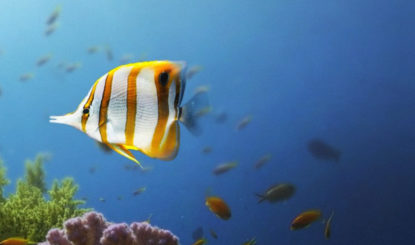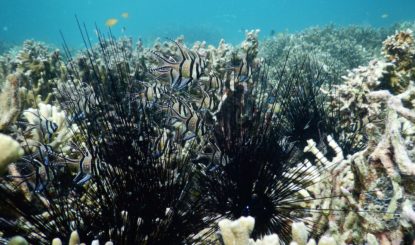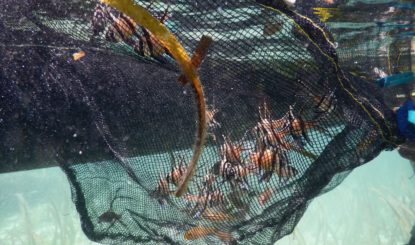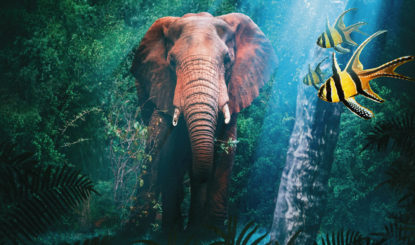From coral reef to „aquarium filler“: the beauty of tropical fish is their doom
Gorgeous coral fish are to be seen everywhere, writes Monica Biondo, decorating aquariums in restaurants, doctors’ offices and living rooms. The coral fish trade is booming! But it’s destroying the reefs themselves, and driving many species to extinction. The Banggai Cardinalfish is among those unlikely to survive as this evil trade lays waste to them and their precious habitat.
This story starts on some small islands in Indonesia, and ends up in the mass market of US, European and Japanese marine aquariums.
The Banggai Cardinalfish is a mere five centimetres, but it’s a small fish with big problems as overfishing for aquariums dwindles its natural population.
The last trade assessment showed that annually, over half a million are caught, and a survey in 2015 estimated that only 1.4 million fish are left (a 90% population decrease) and their habitat is deteriorating quickly.
Although it was discovered in 1920, the Banggai Cardinalfish was long forgotten. In 1994 it was rediscovered and a brisk trade began, which quickly caused concern amongst conservationists. The fish became one of the best-selling marine aquarium ‘fillers’ ever!
The trade in all coral fishes is on the rise. A 2003 UN report estimated that around 24 million individuals are sold annually. More recent figures are not available but given there are now more than two million private, and over a thousand public, aquariums (excluding zoos) this figure is probably much higher.
Worldwide the trade volume of sales for marine tanks (coral fishes and associated equipment) is estimated at over $2 billion a year. However the trade is subject to minimal controls. The UN also stated that for coral reef fishes, on average four out of five die before they reach an aquarium.
Another study in the Philippines suggests that 98% of the fish perish the first year in an aquarium. Only two dozen of the 2,300 traded coral fish species can be bred in captivity in commercial volume, virtually every marine ornamental fish comes from a coral reef.
Coral reefs are also called the “rainforests of the seas”. They are host to 4,000 (one-third of all known) species of fish, 800 species of reef-building corals, and a great many other invertebrates. Coral reefs cover less than 0.1% of the ocean floors and globally one third have already disappeared. Scientists predict that another 15% will disappear in 10 to 20 years.
The lifecycle of the Banggai Cardinalfish
The Banggai Cardinalfish is exceptional as it is one of the few coral fishes that can reproduce in captivity. However, bred fish are more expensive than wild-caught ones and it has the lowest reproductive rate of all known cardinal fishes.
Unlike most others, which produce thousands of eggs and release them into open water, the female lays about 50 eggs that the male quickly fertilizes and then secures in his mouth. He protects both the eggs and the newly-hatched juveniles for around thirty days.
When the trade in Banggai Cardinalfish took off, those who collected the fish were understandably excited. In the US or Europe, Banggai Cardinalfish sell at around $25 or more, while the fishermen earn only around 8¢ per animal. But for them it’s still a useful sum, and local fishermen welcomed the side business even though the trade is unsustainable.
The Banggai Cardinalfish only occurs in only 23 square kilometres distributed in the Banggai Archipelago in Central Sulawesi, Indonesia. These waters lay in the ‘Coral Triangle’ amongst the most species-rich coral reefs of the world. Here widespread destruction of the coral itself is also emerging.
Bang go the Banggai coral reefs
Although long forbidden, fishing for food with dynamite is commonly practised and fishermen don’t even seem to be aware of their misconduct. They openly explain how they build their bombs: an empty beer bottle, fertilizer, kerosene and a sulphur wick. After five to eight seconds – bang!
Underwater it looks like a battlefield as an assortment of dead fish lay submerged or floating. Not only are the fishes dead, but many corals also get blasted away, and the crates of earlier missions can be seen almost everywhere.
Young and adult fish need sea urchins, anemones and branching corals as protection. But because Banggai Cardinalfish live in such shallow waters, this makes them vulnerable. Equipped with a diving mask and a hand net, a man can fish a whole group of Banggai Cardinalfish in a few minutes.
He brings them to a boat and throws them in by the thousands, then off he goes to the next coral colony or sea urchin, while his colleague sorts the fish by size and condition, throwing the dead and dying ones over board. After a few days or weeks stored in pens, the fish will be picked up and shipped for 24 hours to Manado, the capital of North Sulawesi.
All but a few fish die in transit – and even they don’t live much longer
Upon arrival, already a quarter will be dead, and sometimes even the entire catch. Another 15% will be rejected by the buyers due to their poor condition according to the local fishermen. An additional third to half will die later during overseas transport, until finally a miserable remnant ekes out a usually brief existence in the aquarium.
The fishermen should report to the quarantine station how many Banggai Cardinalfish they catch. But there’s few controls here. The islands are far apart and there is little oversight by administrators, let alone sea patrols. Unsurprisingly, there are large discrepancies between the numbers reported by local fishermen, traders and authorities, and the international import figures. Somewhere along the line, fish get ‘lost’.
A new survey completed in March 2015 of 52 sites over 25 islands, clearly shows that the situation has become bleaker. Some populations have gone extinct and the overall abundance is even lower than in the previous survey of 2007, when it was already nine times lower than its historical density (0.06 fish per square meter compared to the baseline of 0.6 fish).
An enquiry at Manado’s quarantine station indicates that control only happens sporadically and that there is just one exporter left in Manado. The officials are former exporters and admit they have abandoned the trade, as there is not enough business. The objection that the quarantine checks are not carried out is smilingly ignored.
At the exporter, half-filled aquariums (some with very hazy water) line a dark hall. Once colour-splendid coral fishes, now languish apathetic and dying, or already dead.
Indonesia blocks CITES listing
Unfortunately, an attempt in 2007 to list the Banggai Cardinalfish under CITES (Convention on International Trade on Endangered Species) failed. Success would have meant that member states would be obliged to collect trade figures. But Indonesia did not support the US-submitted proposal hence it was withdrawn.
Scientists remain convinced that only trade controls can save the Banggai Cardinalfish.
This urgency was underlined by the fact that shortly after the CITES conference in 2007, the IUCN Red List registered the species as “endangered”, meaning that it faces a very high risk of extinction. A glimmer of hope came in January 2016 when the US – the biggest importer – listed the fish as “threatened” under the Endangered Species Act.
And so the struggle to save this little fish goes on. Unfortunately, so too does its exploitation as money-grasping traders make their usual mockery of “sustainable use”.



